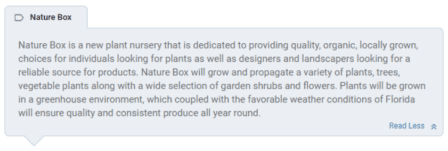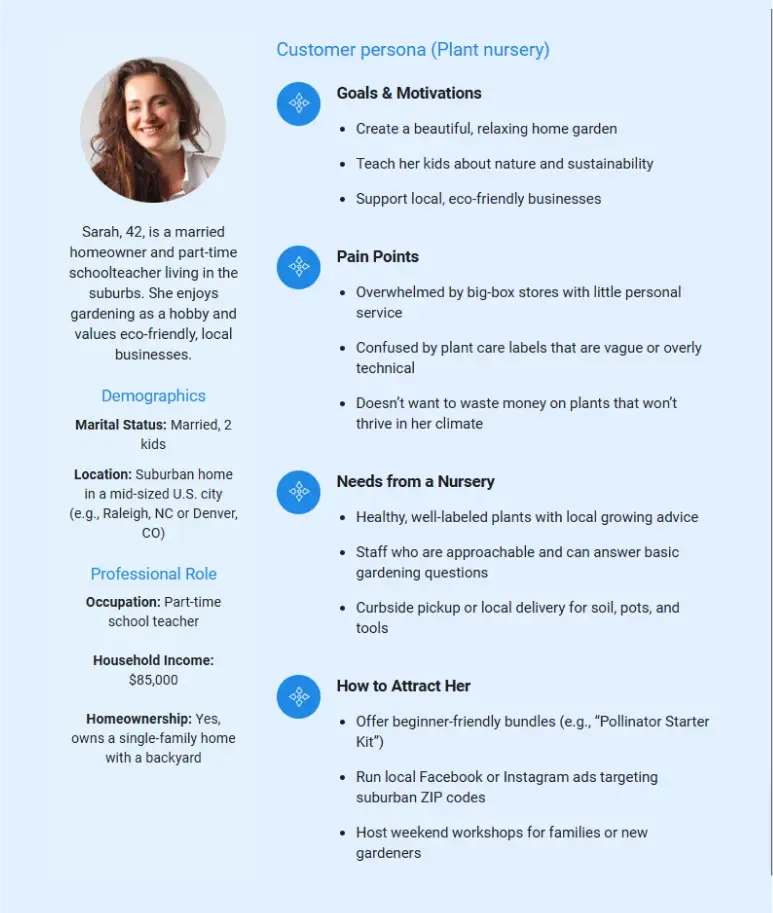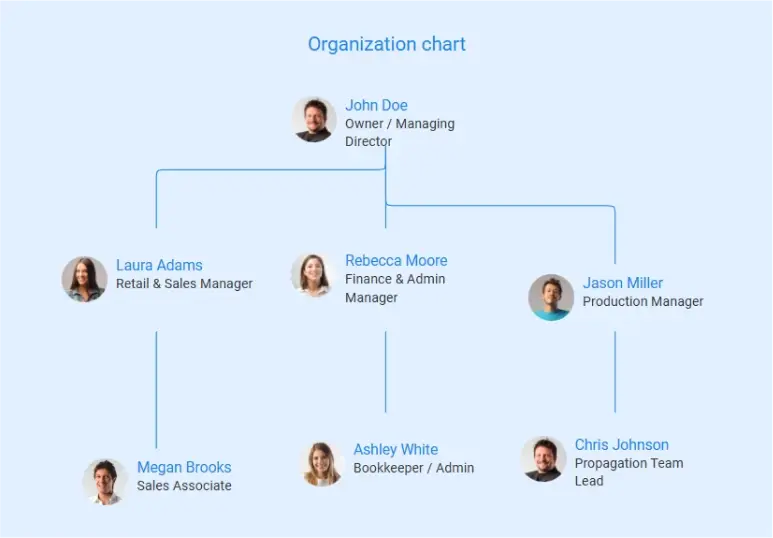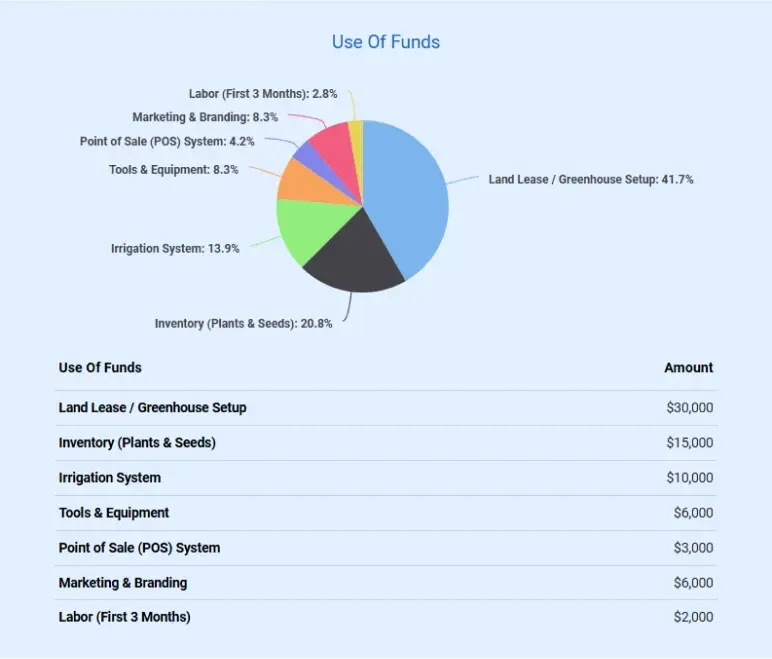Do you feel tired in the caught-up rat race, and just want to follow your passion for nature? Well, a plant nursery is an amazing idea that would help the environment while keeping your pockets full.
But to start a successful plant nursery or get funding, you will need a solid business plan to guide you through the way.
Wondering how to draft your plan?
You’re at the right place. This plant nursery business plan template will help you get started.
How to write a plant nursery business plan?
Writing a plant nursery business plan is a crucial step toward the success of your business. Here are the key steps to consider when writing a business plan:
1. Executive Summary
An executive summary is the first section that offers an overview of the entire business plan. However, it is written after the entire business plan is complete and provides a summary of each section.
Here’s what to cover in this section:
- What’s your business all about?
Are you opening a retail nursery, wholesale grower, or specialty plant shop? Mention what makes your nursery unique. - Where are you located (or operating)?
Mention your setup: urban storefront, rural greenhouse, or online-based. Why is this location ideal for your target market or plant types? - Who are your customers?
Are you targeting home gardeners, interior decorators, landscapers, plant hobbyists, or bulk buyers like offices or hotels? - How will you earn revenue?
List your income sources: potted plants, seedlings, gardening tools, subscriptions, or workshops. Mention if sales are online, offline, or both. - What are your goals?
Share short- and long-term targets. For example: break-even in 12 months, 1,000 monthly customers, or opening a second location in 3 years. - Do you need funding?
If yes, how much do you need? Specify the use of funds, like setting up greenhouses, buying inventory, hiring staff, or launching marketing campaigns.
Make sure your executive summary is clear, concise, and free of jargon. Even someone unfamiliar with your industry should understand your business at a glance.
Say goodbye to boring templates
Build your business plan faster and easier with AI
Plans starting from $14/month

2. Business Overview
The business overview of your business plan provides information in detail about your business. It contains information about the business name, type, location, history, and future goals.
Start by describing what kind of plant nursery business you run and the name of it. You may be running one of the following types of plant nurseries:
| Nursery type | Focus area |
|---|---|
| Tree nursery | Plantation and sale of trees for residential and commercial use |
| Indoor plant nursery | Specializes in indoor and houseplants |
| Aquatic plant nursery | Grows and sells aquatic plants for ponds and water gardens |
For example, here’s the business description for a nursery with the help of Upmetrics:

After stating your type, mention what makes your business stand out. It could be your plant variety, eco-friendly practices, or personalized customer service.
Next, describe how your nursery is structured legally, whether it’s a sole proprietorship, partnership, LLC (Limited Liability Company), or corporation.
Follow that with a note about your location. Where is your nursery based, and why did you choose that spot? It could be close to your market, have good soil, or be easy for logistics.
Now introduce the founders or owners. Share who’s running the business and what responsibilities they hold.
If your nursery is already up and running, briefly mention its background, when you started, any growth milestones, or special recognition.
Lastly, discuss your aspirations for the business. What are your immediate objectives (such as increasing the customer base) and future plans (maybe to move to a new location or open an internet shop)?
Overall, this section should provide a thorough understanding of your plant nursery, its history, and future aspirations. Hence, keep it engaging and precise.
3. Market Analysis
The market analysis section of your business plan should offer a thorough understanding of the industry with the target market, competitors, and growth opportunities. You should include the following components in this section.
Target market
Start by identifying who you’ll be serving. Are your customers home gardeners, landscaping companies, or city municipalities? Try to examine your ideal buyer, like what age group they are in, what they value, and what kinds of plants or services they are most interested in.
Creating a simple buyer persona can help bring clarity to your marketing and product decisions. For example:

Market size and growth potential
Describe your market size and growth potential and whether you will target a niche or a much broader market.
For instance, in 2025, the market value of the nursery and garden stores industry is projected at $54.0 billion.
Competitive analysis
Identify and analyze your direct and indirect competitors. Identify their strengths and weaknesses, and describe what differentiates your plant nursery services from theirs. Point out how you’ll have a competitive edge in the market.
Market trends
Analyze emerging trends in the industry, such as technology disruptions, changes in customer behavior or preferences, etc. Explain how your business will cope with all the trends. For example here is how you should mention the market trends:
Regulatory environment
Lastly, don’t overlook the legal side. Depending on your region, you may need:
- A business license or nursery certificate
- Permits for selling certain plant species
- Insurance for liability or damage
- Environmental compliance when using chemicals or large-scale water usage
Always check with your local authorities to make sure you’re covered.
Here are a few tips for drafting this section:
- Look at gardening websites, forums, or even Instagram to see what people are interested in.
- Visit a few nearby nurseries to check out what they sell and how they do business.
- Talk to people who love gardening; friends, neighbors, or potential customers, and ask what they usually look for when buying plants.
4. Products and Services
The product and services section should describe the specific services and products that will be offered to customers. To write this section should include the following:
List the products and services
Mention the plant nursery products or services your business will offer. This list may include:
| Category | Details |
|---|---|
| Plants | Flowering plants, indoor plants, herbs, shrubs, saplings |
| Soil | Potting soil, garden mix, organic compost |
| Fertilizers | Organic and chemical fertilizers, plant nutrients |
| Pots & containers | Clay pots, plastic containers, ceramic, and hanging pots |
| Landscape designing | Garden planning, installation, and maintenance services |
| Garden decor | Decorative items like pebbles, statues, lights, and fencing |
| Delivery services | Home delivery of plants, bulk orders, and garden kits |
Quality measures
This section should explain how you maintain quality standards and consistently provide the highest quality service. This may include regular maintenance of plants and quality fertilizers.
Additional services
Mention if your plant nursery offers any additional services. Like:
- Plant maintenance services (watering, pruning, pest control)
- Workshops & training
- Corporate gifting solutions
- Seasonal garden planning
- Online plant care support
In short, this section of your plan must be informative, precise, and client-focused. By providing a clear and compelling description of your offerings, you can help potential investors and readers understand the value of your business.
5. Sales and Marketing Strategies
It’s not enough to grow great plants; people need to know about them, trust you, and feel good buying from your nursery. That’s where a clear marketing and sales strategy comes in.
This section explains how you’ll reach the right customers, get them through your doors (or to your website), and keep them coming back for more.
Here’s what your plan should cover:
- Branding and positioning (name of your nursery, logo, tagline, and the way it looks in general)
- Digital marketing (a simple website, plus active Instagram or Facebook pages with photos, tips, and updates)
- Advertisement and promotion (local flyers, small social media advertising campaigns, and promotion during high season peaks)
- Community collaborations (team up with landscapers, gardening clubs, ecoshops, or even local cafes)
- Sales and buying experience (make it easy for people to visit, browse, get advice, and make a purchase)
- Customer loyalty (a loyalty card, monthly care hints, or little rewards to the repeat customer)
You don’t need a huge marketing budget. A few smart moves, like staying active online and building local relationships, can make a big difference.
6. Operations plan
The operations plan is about how your business will actually run day to day. It should cover the behind-the-scenes stuff like: Your team, your process, and the tools that help you stay efficient and consistent.
To make it clearer, here’s a simple breakdown:
| What’s involved | How your business can handle it |
|---|---|
| Staffing & training | Think about how many staff you’ll need. Maybe a couple of skilled staff to manage plant care or customers. You’ll also need to train them on basic plant handling, safety, and customer service. |
| Daily operations | This includes everything from prepping soil and watering plants to managing stock and arranging displays. Write out your usual daily or weekly flow. |
| Tools & equipment | List the key things you’ll use, like watering cans, sprayers, planting trays, and pruning tools. They keep your work smooth and professional. |
Adding these components to your operations plan will help you lay out your business operations, which will eventually help you manage your business effectively.
7. Management Team
A strong and capable team plays a big role in the success of any plant nursery business. Even if you’re just starting out, having the right people in place or at least planning for them can help you run things smoothly and grow over time.
Start by mentioning the key people involved in your business. This is normally the founder or co-founders who give the general direction and decision-making.
In case you have any managers who are related to daily business activities, marketing, or sales, then list their responsibilities.
Then, outline a simple organizational structure. Show who reports to whom and how responsibilities are divided across the team.
Even with a small team, having clarity in roles and reporting lines helps avoid confusion and keeps things organized. Take a look at this sample organization chart:

Lastly, if you have any advisors or consultants on board, such as a horticulture expert, pest control consultant, or a small business advisor, be sure to mention them. Their involvement adds credibility to your business plan and shows that you’re open to expert guidance as you grow.
Over and above, this section should describe the key personnel associated with your plant nursery business, highlighting how you have the perfect team to succeed.
8. Financial Plan
Your financial plan section should provide a summary of your business’s financial projections for the first few years (aim for 3-5 years). Here are some key elements to include in your financial plan:
- Startup costs: You should estimate the amount of money that you will require to start your nursery up such as land, equipment, and stock.
- Revenue forecast: Estimate the amount of revenue you intend to generate through plant sales, services, and seasonal offers.
- Operating expenses: Write down the expenses you have to face to run the nursery on a monthly basis (wages of staff, rent, electricity, and supplies that will need to be bought).
- Profit & loss statement: Compare your expected income and expenses to see whether your business will make a profit or face a loss over time.
- Cash flow statement: Keep the flow of money in and out of your business by tracking it, so that you do not run short during slow periods.
- Balance sheet: Summarize what your business owns (assets), owes (liabilities), and what’s left over (equity).
- Break-even analysis: Find out how much you need to earn just to cover your costs before you start making a profit.
If you need capital, mention how much you’re looking for and what it will be used for. To make things clearer, here’s how the ₹90,000 fund usage can be shown:

Be realistic with your financial projections, and make sure you offer relevant information and evidence to support your estimates.
9. Appendix
The appendix supports your plant nursery business plan by providing key documents and data that back up the main sections. You may include:
- Financial projections and various income statements (3–5 years)
- Business licenses, permits, and registration documents
- Lease agreement or land ownership proof
- Market research data and customer insights
- Product catalog, brochures, or service list
- Partnership contracts or supplier agreements
While planning this section, make sure you only add documents that support your business plan directly. Avoid including anything outdated or unrelated.
Download a free plant nursery business plan template
Feeling a bit stuck on how to plan it all out? Don’t worry, we’ve got your back. Just download our free plant nursery business plan template PDF to make things easier.
This template gives you a ready-made structure to follow. It walks you through every section, from the executive summary to financial projections. Just fill in your business details, make a few tweaks, and you’re good to go.
The Quickest Way to turn a Business Idea into a Business Plan
Fill-in-the-blanks and automatic financials make it easy.
Summary
You’ve seen what goes into a solid plant nursery business plan. With this free template, writing your own should feel much more doable.
But not sure where to begin, or just want a faster way to create your plan?
Upmetrics can help. It makes business planning quicker and easier with its AI-powered capabilities, advanced financial forecasting features, and step-by-step guidance.
Why wait? Start building your nursery business plan today.



